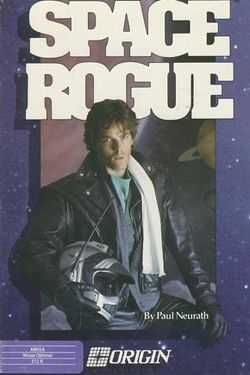Space Rogue
| Space Rogue | |
|---|---|
 The cover of Space Rogue | |
| Developer(s) | Origin Systems |
| Publisher(s) | Origin Systems
Wave Brain (PC-9801 and X68000) |
| Designer(s) | Paul Neurath |
| Platform(s) | Apple II, Commodore 64, MS-DOS, Macintosh, Amiga, Atari ST, PC-9801, X68000, and FM Towns |
| Release date(s) | 1989 (Apple II, Commodore 64, and MS-DOS)
/ 1990 (PC-9801) / 18 December 1990 (X68000) |
| Genre(s) | Space combat simulator |
| Distribution | Four 5.25" Floppy Disks (Apple II, Commodore 64, and MS-DOS)[1]; Two 3.5" Floppy Disks (MS-DOS, Amiga, Atari ST, and Macintosh); CD (FM Towns) |
Space Rogue (also known as スペースローグ in Japan [2][3]) is a Science Fiction computer game released in 1989 by Origin Systems, makers of the hit Ultima series, for the Apple II and Commodore 64, that was later on ported to MS-DOS, Macintosh, Amiga, Atari ST, PC-9801, X68000, and FM Towns. The FM Towns version had its intro remade with slight animations and new illustrations, along with scrolling Japanese text. The FM Towns version also had exclusive CD quality background music.[4]
The game combined elements of both a space combat simulator and a role-playing game, like the much later X: Rebirth and Star Citizen. It is notable for being the first game designed for Origin by Paul Neurath, who went on to found Blue Sky Productions (later renamed Looking Glass Studios).
Space Rogue can be considered as the spiritual predecessor to Origin's Wing Commander series. The press release for Space Rogue stated that it is "the first of its kind in science-fiction/3D space flight simulation. An ORIGIN Cinematic Experience™"[5] Implying that Space Rogue was originally meant to be a series of its own ('Ultima in Space'), before later on Origin turned to the Wing Commander series instead.
Story
The player takes on the role of a crew aboard the Princess Blue, who was sent by his captain to investigate a small derelict spacecraft, the Sunracer class Jolly Roger. While he is on board the Jolly Roger, a group of aliens called the Manchis attack the Princess Blue using their Vulture class ships, destroying it.
Left only with the Jolly Roger, little money, and no ties to anyone. The Player can now decide his fate from there. He could engage in piracy, hunt bounties, become an interstellar merchant, or become embroiled in the interplanetary politics.
Protagonist
While the game pretty much left out most of the player's character identity for roleplaying purposes, the manual of Space Rogue revealed that the player's character name is "Neil Shapiro" (mentioned in the introduction of the FM Towns version), the only son of a famous jeweler throughout the Far Arm.
Gameplay
The game is played switching back and forth between a traditional top-down style RPG (e.g. Ultima) and a 3D space combat simulator (e.g. Elite). Visiting starships, space stations, outposts, planets, and so on. The player is able to travel from one solar system to another using the ancient Malir Gates' wormhole, a form of 'Star Gate'. A mini game of travelling through rings must be successfully completed first before the player can reach his intended system, a failed mini game will cause an aborted interstellar travel.
During the 3D space flight part of the game, the game offers 3 point of views: First person, a chase behind the craft, and cinematic.
There is also an arcade game called "Hive!" in the bars, that can be played by the player. The gameplay is a 2D top-down shooter, with the player moving on foot, attacking the incoming Manchis. The ship in the arcade game resembled the Sunracer class ship featured in the manual that came with the Space Rogue game. After completing five levels, the player can win money which can then be spent in the rest of the Space Rogue game.
Reviews
The game was reviewed in 1990 in Dragon #153 by Hartley, Patricia, and Kirk Lesser in "The Role of Computers" column. The reviewers gave the game 41⁄2 out of 5 stars.[6]
Computer Gaming World called Space Rogue "an interesting blend of arcade action, role-playing interaction and economic strategy."[7]
Compute! stated that "the best of flight simulation and role-playing come together in Space Rogue ... believably and with style."[8]
Zzap64, Issue #58, 1990: "I Thought Elite could never be beaten as the greatest ever space game, but after playing Space Rogue for hours on end I've changed my mind. This totally outclasses Elite and is the best Space Game for any machine!"
References
- ↑ A press release of Space Rogue mentioning the distributed mediums of the game.
- ↑ スペースローグ (Space Rouge) for the PC-9801, published by ウエーブトレイン (Wave Brain). From a PC-9801 DATABASE archive.
- ↑ スペースローグ (Space Rouge) for the X68000, published by ウエーブトレイン (Wave Brain). From a 8-Bitters archive.
- ↑ "Space Rogue FM Towns Gameplay"
- ↑ A press release of Space Rouge.
- ↑ Lesser, Hartley, Patricia, and Kirk (January 1990). "The Role of Computers". Dragon (153): 76–79, 102.
- ↑ DeWitt, Omar (December 1989). "Life in the Fast Frame". Computer Gaming World. p. 38.
- ↑ Guerra, Bob (December 1989). "Space Rogue". Compute!. p. 132. Retrieved 11 November 2013.
External links
- Review of Space Rogue from Mister Dai
- Review of Space Rogue from The Game Machine (December 1989) on Amiga Magazine Rack website